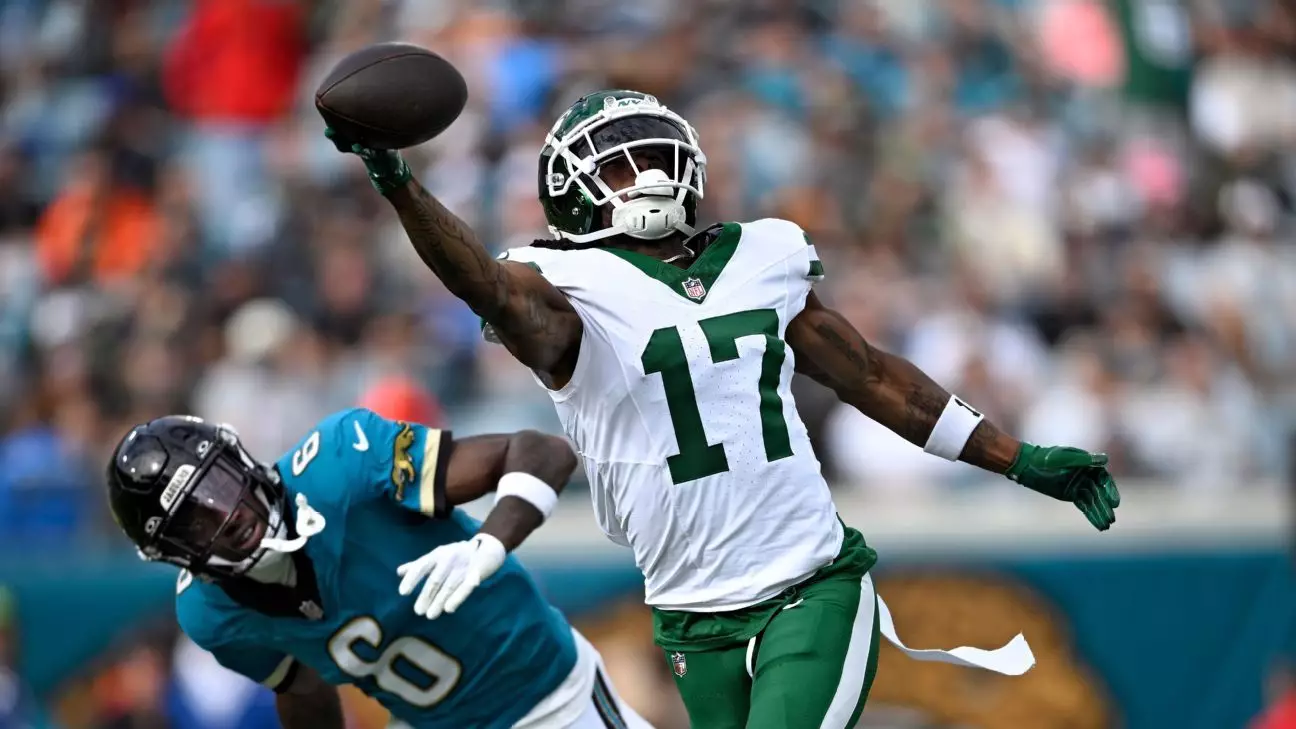In a decisive purge from the Aaron Rodgers era, the New York Jets have made a significant move by releasing wide receiver Davante Adams, signaling a clear shift in the team’s direction. After acquiring Adams from the Las Vegas Raiders in a bid to recreate the Rodgers-Adams chemistry from their Green Bay days, the Jets are now cutting ties with a player who, despite his still potent performance, has become a financial liability. With the decision to release Adams, the Jets are not merely shedding a high-cost player; they are also freeing themselves from the narratives and expectations that have shackled the franchise since they went all-in for a star-studded roster.
The financial implications of this decision are profound. Adams was set to account for a staggering $38.3 million against the salary cap in 2025, a figure that clearly proved untenable for a team eager to reposition itself competitively in the league. By cutting him, the Jets have created $29.9 million in cap space for the current year, a strategic maneuver that provides them with flexibility and resources to pursue new talent. This bold move reflects a desire not just to rebuild but to embark on a renaissance – a chance for the Jets to redefine themselves.
Adams arrived in New York with lofty expectations, a perennial Pro Bowl receiver who seemed destined to elevate the Jets’ offense to new heights. His 67 receptions for 854 yards and seven touchdowns in just 11 games last season hinted at his class. However, the Jets’ desperate attempt to ignite the long-dormant ‘Rodgers magic’ failed spectacularly, culminating in a dismal 5-12 record. The reality is that the Jets gambled on an illusion, hoping that past glories would automatically transform an underperforming team. The results bore out the folly of such wishes – after all, NFL success is built on more than just star power.
What was also evident during Adams’ tenure in New York was the dysfunctional dynamics within the offense. The Jets brought in Adams to empower the passing game, yet the reality became a clear favoritism toward him over fellow receivers like Garrett Wilson. With Adams targeted 112 times compared to Wilson’s 87, the discord frustrated a young talent who is now thrust into the spotlight as the Jets’ primary weapon. Maintaining a focus on collective development must outweigh the reliance on specific star players moving forward.
As the Jets continue to move away from the excesses of the past, the receiver room appears painfully thin. With Adams gone and Allen Lazard presumably on the chopping block, the Jets face the daunting challenge of scavenging the market for viable wide receiver options. Their depth chart is now limited to Garrett Wilson and a handful of inexperienced players, which can hardly instill confidence heading into free agency. This scenario emphasizes the critical nature of rebuilding – not on a platform of marquee names but through smart acquisitions that can harmoniously fit into a cohesive game plan.
Wilson now stands as the focal point of the receiving corps, with strong credentials having achieved three consecutive seasons of over 1,000 yards. However, the increased responsibility may come with its own burdens, especially after witnessing how the chemistry between Adams, Rodgers, and himself faltered. Ensuring that Wilson can harness his potential while preventing further disruptions will be essential in defining the Jets’ next few seasons. A successful rebuild cannot afford another misalignment of talents and personalities.
The Jets’ front office shakeup, with new coach Aaron Glenn and general manager Darren Mougey at the helm, indicates a broader commitment to restructuring the team’s identity. This shift is welcome, as the previous regime’s reliance on past connections has led to a landscape that lacks coherence or purpose. Parting ways with Rodgers’ close ally, offensive coordinator Nathaniel Hackett, further cements the notion that the organization is serious about redefining its brand.
As the Jets navigate free agency and the draft, they must embrace a culture that prioritizes compatibility over mere talent aggregation. The need for cohesive teamwork cannot be overstated; when individual aspirations overshadow collective goals, the team’s performance invariably suffers.
The Jets’ departure from the Rodgers-Adams alliance allows them to reevaluate their approach while also sending a clear message: they are ready to rewrite the narrative of their franchise. This is not just about purging contracts; it is about reimagining the Jets as a competitive and cohesive unit ready to tackle the challenges of the league head-on.


Leave a Reply